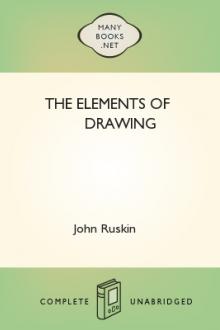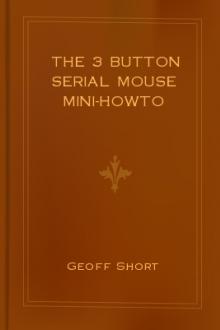The Elements of Drawing by John Ruskin (smart books to read .txt) 📕

xii. One task, however, of some difficulty, the student will find I have not imposed upon him: namely, learning the laws of perspective. It would be worth while to learn them, if he could do so easily; but without a master's help, and in the way perspective is at present explained in treatises, the difficulty is greater than the gain. For perspective is not of the slighte
Read free book «The Elements of Drawing by John Ruskin (smart books to read .txt) 📕» - read online or download for free at americanlibrarybooks.com
- Author: John Ruskin
- Performer: -
Read book online «The Elements of Drawing by John Ruskin (smart books to read .txt) 📕». Author - John Ruskin
245. I should think the reader cannot but feel the kind of harmony there is in this composition; the entire purpose of the painter to give us the impression of wild, yet gentle, country life, monotonous as the succession of the noiseless waves, patient and enduring as the rocks; but peaceful, and full of health and quiet hope, and sanctified by the pure mountain air and baptismal dew of heaven, falling softly between days of toil and nights of innocence.
246. All noble composition of this kind can be reached only by instinct; you cannot set yourself to arrange such a subject; you may see it, and seize it, at all times, but never laboriously invent it. And your power of discerning what is best in expression, among natural subjects, depends wholly on the temper in which you keep your own mind; above all, on your living so much alone as to allow it to become acutely sensitive in its own stillness. The noisy life of modern days is wholly incompatible with any true perception of natural beauty. If you go down into Cumberland by the railroad, live in some frequented hotel, and explore the hills with merry companions, however much you may enjoy your tour or their conversation, depend upon it you will never choose so much as one pictorial subject rightly; you will not see into the depth of any. But take knapsack and stick, walk towards the hills by short day's journeys,—ten or twelve miles a day—taking a week from some starting-place sixty or seventy miles away: sleep at the pretty little wayside inns, or the rough village ones; then take the hills as they tempt you, following glen or shore as your eye glances or your heart guides, wholly scornful of local fame or fashion, and of everything which it is the ordinary traveler's duty to see, or pride to do. Never force yourself to admire anything when you are not in the humor; but never force yourself away from what you feel to be lovely, in search of anything better; and gradually the deeper scenes of the natural world will unfold themselves to you in still increasing fullness of passionate power; and your difficulty will be no more to seek or to compose subjects, but only to choose one from among the multitude of melodious thoughts with which you will be haunted, thoughts which will of course be noble or original in proportion to your own depth of character and general power of mind; for it is not so much by the consideration you give to any single drawing, as by the previous discipline of your powers of thought, that the character of your composition will be determined. Simplicity of life will make you sensitive to the refinement and modesty of scenery, just as inordinate excitement and pomp of daily life will make you enjoy coarse colors and affected forms. Habits of patient comparison and accurate judgment will make your art precious, as they will make your actions wise; and every increase of noble enthusiasm in your living spirit will be measured by the reflection of its light upon the works of your hands.—Faithfully yours,
J. Ruskin.
[41] I give Rossetti this pre-eminence, because, though the leading Pre-Raphaelites have all about equal power over color in the abstract, Rossetti and Holman Hunt are distinguished above the rest for rendering color under effects of light; and of these two, Rossetti composes with richer fancy, and with a deeper sense of beauty, Hunt's stern realism leading him continually into harshness. Rossetti's carelessness, to do him justice, is only in water-color, never in oil.
[42] All the degradation of art which was brought about, after the rise of the Dutch school, by asphaltum, yellow varnish, and brown trees would have been prevented, if only painters had been forced to work in dead color. Any color will do for some people, if it is browned and shining; but fallacy in dead color is detected on the instant. I even believe that whenever a painter begins to wish that he could touch any portion of his work with gum, he is going wrong.
It is necessary, however, in this matter, carefully to distinguish between translucency and luster. Translucency, though, as I have said above, a dangerous temptation, is, in its place, beautiful; but luster or shininess is always, in painting, a defect. Nay, one of my best painter-friends (the "best" being understood to attach to both divisions of that awkward compound word,) tried the other day to persuade me that luster was an ignobleness in anything; and it was only the fear of treason to ladies' eyes, and to mountain streams, and to morning dew, which kept me from yielding the point to him. One is apt always to generalize too quickly in such matters; but there can be no question that luster is destructive of loveliness in color, as it is of intelligibility in form. Whatever may be the pride of a young beauty in the knowledge that her eyes shine (though perhaps even eyes are most beautiful in dimness), she would be sorry if her cheeks did; and which of us would wish to polish a rose?
[43] But not shiny or greasy. Bristol board, or hot-pressed imperial, or gray paper that feels slightly adhesive to the hand, is best. Coarse, gritty, and sandy papers are fit only for blotters and blunderers; no good draughtsman would lay a line on them. Turner worked much on a thin tough paper, dead in surface; rolling up his sketches in tight bundles that would go deep into his pockets.
[44] I insist upon this unalterability of color the more because I address you as a beginner, or an amateur: a great artist can sometimes get out of a difficulty with credit, or repent without confession. Yet even Titian's alterations usually show as stains on his work.
[45] It is, I think, a piece of affectation to try to work with few colors: it saves time to have enough tints prepared without mixing, and you may at once allow yourself these twenty-four. If you arrange them in your color-box in the order I have set them down, you will always easily put your finger on the one you want.
Cobalt Smalt Antwerb blue Prussian blue Black Gamboge Emerald green Hooker's green Lemon yellow Cadmium yellow Yellow ocher Roman ocher Raw sienna Burnt sienna Light red Indian red Mars orange Extract of vermilion Carmine Violet carmine Brown madder Burnt umber Vandyke brown SepiaAntwerp blue and Prussian blue are not very permanent colors, but you need not care much about permanence in your work as yet, and they are both beautiful; while Indigo is marked by Field as more fugitive still, and is very ugly. Hooker's green is a mixed color, put in the box merely to save you loss of time in mixing gamboge and Prussian blue. No. 1 is the best tint of it. Violet carmine is a noble color for laying broken shadows with, to be worked into afterwards with other colors.
If you wish to take up coloring seriously you had better get Field's "Chromatography" at once; only do not attend to anything it says about principles or harmonies of color; but only to its statements of practical serviceableness in pigments, and of their operations on each other when mixed, etc.
[46] A more methodical, though under general circumstances uselessly prolix way, is to cut a square hole, some half an inch wide, in the sheet of cardboard, and a series of small circular holes in a slip of cardboard an inch wide. Pass the slip over the square opening, and match each color beside one of the circular openings. You will thus have no occasion to wash any of the colors away. But the first rough method is generally all you want, as, after a little practice, you only need to look at the hue through the opening in order to be able to transfer it to your drawing at once.
[47] If colors were twenty times as costly as they are, we should have many more good painters. If I were Chancellor of the Exchequer I would lay a tax of twenty shillings a cake on all colors except black, Prussian blue, Vandyke brown, and Chinese white, which I would leave for students. I don't say this jestingly; I believe such a tax would do more to advance real art than a great many schools of design.
[48] I say modern, because Titian's quiet way of blending colors, which is the perfectly right one, is not understood now by any artist. The best color we reach is got by stippling; but this is not quite right.
[49] See Note 6 in Appendix I.
[50]





Comments (0)